
* World War II was the era of the "dive bomber", an attack aircraft designed to perform precision bombing of targets by diving down on them at a steep angle. Dive bombing was particularly attractive for attacking rapidly moving naval vessels engaged in evasive action. The most prominent American contribution to dive-bomber design was the Douglas "SBD Dauntless", which helped the US score major naval victories against the Japanese in the early days of the Pacific War. Although the Dauntless was somewhat antiquated, it was rugged and reliable, and proved an excellent weapon in the hands of aircrews who knew how to use it.
The obsolescent nature of the Dauntless was understood even before Pearl Harbor, and so work was begun on what was hoped to be an improved successor, the Curtiss "SB2C Helldiver". In fact, the Helldiver proved a disappointment, less effective in many critical respects than the Dauntless and much less liked by aircrews; the Helldiver would not long outlive the Dauntless in operational service. This document provides a history and description of the Dauntless and the Helldiver.
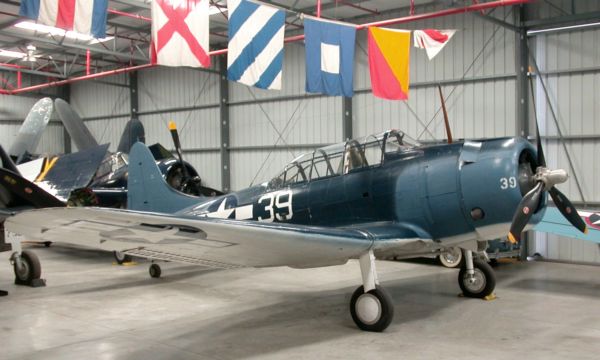
* Northrop Corporation had been founded in El Segundo, California, in 1932 by John Northrop, who had been an employee of Douglas Aircraft. It wasn't exactly a parting of the ways between Northrop and Douglas, since Douglas provided him with backing and retained ownership over the Northrop firm. The relationship between Northrop and Douglas was good for a time, with Northrop making a splash with advanced aircraft designs, such as the fast Gamma mailplane.
In 1934, the US Navy Bureau of Aeronautics (BuAer) issued a request for a dive bomber, with Northrop / Douglas senior engineer Edward H. Heinemann submitting a design that was accepted over the competition, the Navy ordering a single prototype under the designation of "XBT-1" -- the "B" for standing for "bomber" and the "T" (somehow) for "Northrop". Initial flight of the prototype was on 19 August 1935, with the aircraft powered by a Pratt & Whitney (P&W) R-1535-66 Twin Wasp Junior 14-cylinder two-row air-cooled radial engine, providing 520 kW (700 HP) and driving a two-bladed propeller. The XBT-1 was refitted with an R-1535-94 Twin Wasp Junior with 615 kW (825 HP) in December 1935.
In September 1936, the Navy ordered 54 production "BT-1s", with 53 actually delivered. The BT-1 featured tailwheel landing gear, with semi-retractable main gear that hinged backwards into fairings under the wings, and a fixed tailwheel. The original design had featured "split flaps" for dive braking, with the flaps extending above and below the wing. These flaps were modified with an array of holes in the production BT-1s, and the "Swiss cheese" flaps would remain a distinctive feature of the subsequent aircraft line. The BT-1 also differed from the XBT-1 in having a larger, rounded tailfin, and a modified cowling.
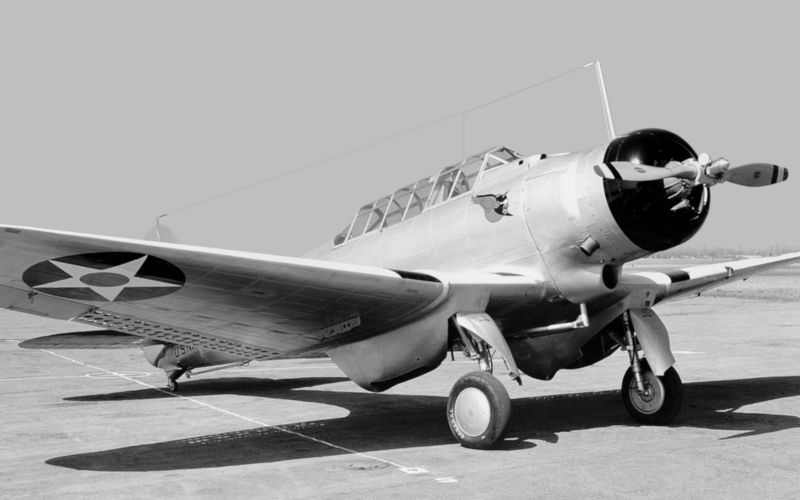
The BT-1 proved highly unsatisfactory in service, being underpowered and suffering from nasty handling characteristics, but the Navy didn't give up on Northrop. The 54th BT-1 was actually completed as the "XBT-2", with a more powerful engine and other changes. In its initial configuration, the XBT-2 performed its first flight on 25 April 1938, only to still prove disappointing. The aircraft was flown to Langley, Virginia, to be tested in a big wind tunnel operated by the US National Advisory Committee on Aeronautics (NACA, the main predecessor of the modern National Aviation & Space Administration, NASA). After the tests, the aircraft went through an extensive redesign.
By this time, Northrop had quit the company to form another, of course being named "Northrop Aircraft" once more, with the "old" Northrop company reverting to Douglas control as the "El Segundo" division. The drastically modified XBT-2 prototype, which had only a general resemblance to the old BT-1, was accepted by the US Navy in 1939, with a production order placed in February of that year for 144 aircraft, to be designated "SBD-1" -- the "SB" standing for "scout bomber" and the "D" of course for "Douglas". Initial service deliveries of the "Dauntless", as it had been named, were in late 1940.
BACK_TO_TOP* The Dauntless was a two-seat, low-wing monoplane. Oddly for a carrier aircraft, it did not have folding wings, the decision having been made to design the wing for structural strength in a way that precluded a wingfold. The wing's outboard panels had a noticeable dihedral, though the tailplane was flat. Control surface arrangement was generally conventional -- ailerons, elevators, rudder, all fabric-covered -- except for large metal flaps, split inboard and outboard, with the outboard section also having a top flap that could be hinged out along with the bottom flap to act as a dive brake. The flaps were all of the "Swiss cheese" configuration. The perforations reduced buffet on a dive and permitted wider extension of the dive brakes, improving braking effect.
The Dauntless had tailwheel landing gear, with the main gear hinged in the wings to retract in towards the fuselage, and with a fixed tailwheel. The pilot and rear gunner / radio operator sat in tandem, the back-seater facing the rear, with the canopy sections sliding towards the center to open.
The Dauntless could carry up to a 725-kilogram (1,600-pound) bomb on a swinging release cradle under the fuselage, and also had a pylon for a single 45-kilogram (100-pound) bomb or other relatively small store under each wing. The release cradle allowed the bomb to clear the propeller during a dive attack. The cradle was not used in level attack, the bomb being dropped directly in that case.
The Dauntless had two 12.7-millimeter (0.50-caliber) M2 Browning machine guns fixed in the top of the nose cowling and firing through the propeller using synchronizing gear. The receivers of the guns protruded into the cockpit, giving the pilot some ability to clear jams. There was also a single hand-held 7.62-millimeter (0.30-caliber) Browning on a rear-facing flexible mount, with this weapon handled by the back-seater. The rear gun was stowed underneath doors on the fuselage behind the cockpit when not in use. An antique-looking telescopic sight was used to aim the forward guns and for dive-bombing attacks.
The SBD-1 was powered by a Wright R-1820-32 Cyclone 9-cylinder air-cooled radial with 745 kW (1,000 HP), driving a three-bladed adjustable-pitch propeller with a spinner. The SBD-1 had a distinctive "fat" carburetor inlet at the top of the engine cowling, and also carried flotation gear for ditching at sea. It had four internal fuel tanks in the wing center section with a total capacity of 796 liters (210 US gallons) -- including two main tanks with 341 liters (90 US gallons) each, and two auxiliary tanks with 57 liters (15 US gallons) each. With bombload, this restricted the operational radius to a mere 370 kilometers (200 NMI). The Navy was not happy about the limited range, nor about the fact that the SBD-1 lacked armor.
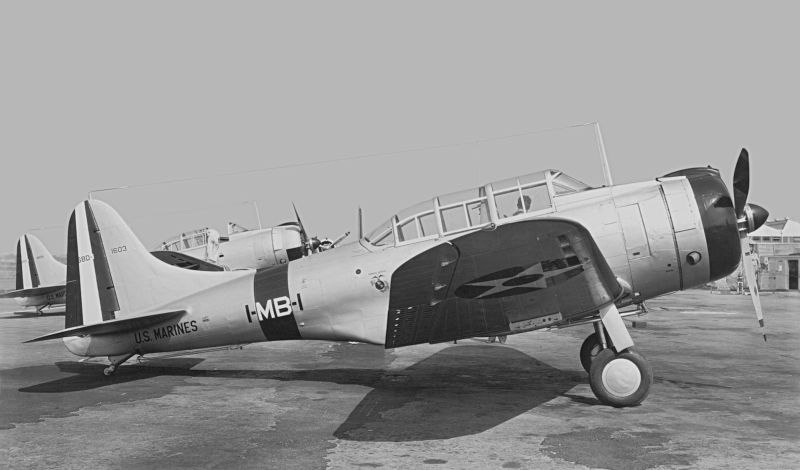
Douglas was working on improvements and so the Navy decided to accept the first 57 of the initial order for 144 machines as was, with production flowing to the improved "SBD-2" with the 58th machine. The SBD-2 still lacked armor, but the fuel capacity was increased, with the two main tanks retained, the auxiliary tanks removed, and a 246-liter (65 US gallon) tank added to each outer wing panel to provide a total fuel capacity of 1,175 liters (310 US gallons). Range was proportionately increased, but takeoff weight necessarily increased as well, and one of the Brownings in the cowling was often removed in the field.
The SBD-2 also featured an autopilot; the carburetor intake was reduced in size as well, giving the aircraft a somewhat more modern appearance. The SBD-2s were not everything that was wanted, but the Navy still accepted the remaining 87 aircraft of the initial order in this configuration. Incidentally, there's a common perception that the Marines tend to be on the back end of the US military procurement queue; Marines will on occasion object to this suggestion, but it should be noted that all the SBD-1s were passed on to the USMC, while the Navy retained the SBD-2s. The initial SBD color scheme was light gray overall, this being changed to light gray underneath and medium blue gray on top. Prewar national insignia featured a five-pointed star with a red "meatball" in the center.
* Neither the SBD-1 nor the SBD-2 were really acceptable for combat. The first Dauntless that was up to being sent into action was the "SBD-3", which ironically was produced for the Aeronavale, the French Navy's air arm. 174 were ordered by the French, but with the fall of France in the spring of 1940 that production batch was picked up by the US Navy, which ordered 410 more, for a total of 584.
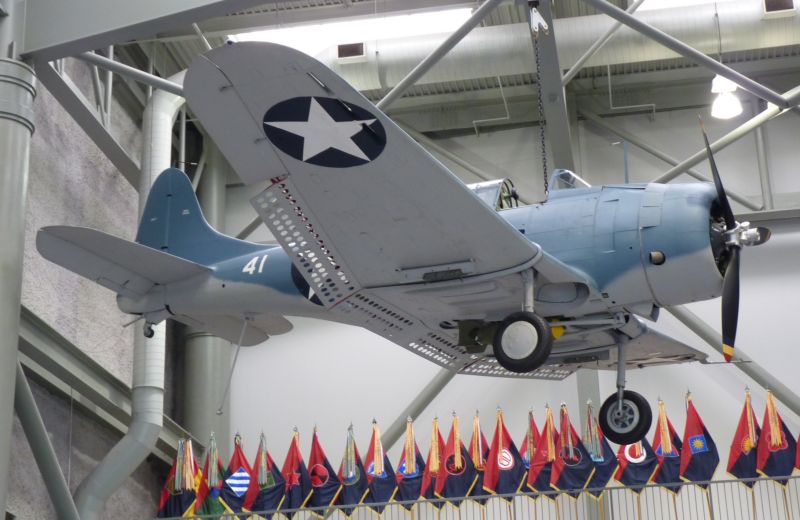
The SBD-3 seemed almost identical to the SBD-2 externally, but featured crew and fuel system armor protection, plus an armored windscreen. The internal fuel tanks were all self-sealing, and provided a fuel supply of 985 liters (260 US gallons). The SBD-3 was fitted with an R-1820-53 engine, with the same power output as the older R-1820-32 but with some technical improvements. The cowling configuration was modified slightly.
Some sources claim that the SBD-1 and SBD-2 had 7.62-millimeter Brownings in the cowling, and that the 12.7-millimeter Brownings were actually introduced in the SBD-3. The single 7.62-millimeter rear gun was often updated in the field to a double mount, with an improved double gun system featuring a power-boosted ring mount introduced late in SBD-3 production. The new production rear gun fit eliminated the rear-fuselage doors for stowage of the rear guns in favor of sliding panels.

Although efforts were made to decrease weight, for example through elimination of the flotation gear and use of lighter airframe components, the empty weight of the SBD-3 was 2,800 kilograms (6,180 pounds), versus the 2,505 kilograms (5,525 pounds) of the SBD-1 and SBD-2. However, performance only suffered slightly.
BACK_TO_TOP* The Marines started to receive SBD-1s in June 1940, and by the time the Imperial Japanese Navy (IJN) attacked on Pearl Harbor on 7 December 1941, it was being flown by "Marine Air Group (MAG) 11" and MAG 21. MAG 21 was stationed in Hawaii and its Dauntlesses were shot up on the ground during the Pearl Harbor attack, with 17 destroyed and the remaining 12 badly damaged. Surviving Navy SBDs hunted for the Japanese fleet over the following days, but the IJN had made a clean getaway. However, on 10 December a Dauntless claimed the sinking of the IJN submarine I-70. The SBD had drawn its first blood.
In early 1942, the US Navy conducted a series of hit-and-run raids on Japanese bases in the Pacific. They were intended to bolster civilian morale and hopefully throw the Japanese off balance. The "revenge raids" caused little harm but substantial irritation to the Japanese, and they provided combat experience to Navy crews that would come in useful when the time came to take serious action against the enemy. One change resulting from these early operations was the elimination of the red "meatball" in the middle of the US national insignia since it tended to look like a Japanese "rising sun" from a distance, leading to "friendly fire" problems.
In early May 1942, US Navy signals intelligence revealed that the Japanese were planning an amphibious assault against Port Moresby in southern New Guinea, increasing the threat to Australia. A US Navy task force built around the carriers LEXINGTON and YORKTOWN moved to block the Japanese. On 7 May 1942, Dauntlesses sank the light carrier SHOUHOU, resulting in the excited report: "Scratch one flattop!" However, the next day the Japanese got the better of the match, sinking the LEXINGTON and damaging the YORKTOWN, though the SBDs badly damaged the heavy carrier SHOUKAKU in return. Both sides also lost smaller vessels and numbers of planes, with the Japanese suffering greater aerial losses.
The results of the Battle of the Coral Sea, as the confrontation became known in the history books, gave the Japanese a clear but not overwhelming tactical victory -- though they believed, with some reason, that they had sunk both the LEXINGTON and YORKTOWN and were very enthusiastic about the results of the clash. However, the Americans, who had been losing badly in general since the beginning of the war in the Pacific, were encouraged at getting into a fight with the IJN and inflicting roughly as much damage on the Japanese as the Japanese had inflicted on them. In any case, the Japanese operation against Port Moresby was called off, making the battle a clear strategic win for the Allies.
* The IJN had enough of putting up with annoyances and confrontations with the Americans, and planned a "decisive battle" that would knock the US Navy out of the Pacific once and for all. Masked by a diversionary operation to the Aleutians in the far North Pacific, a major Japanese fleet would lure the Americans into battle near Midway Island in the Central Pacific and destroy them.
Fortunately, US Navy signals intelligence was once again a step ahead of the IJN, and a task force built around the hastily-repaired YORKTOWN, as well as the ENTERPRISE and HORNET, was ready for them. On 4 June, the Americans found the Japanese fleet first, with an attack by Douglas TBD Devastator torpedo bombers being slaughtered. However, the Devastators had managed to distract the Japanese so that they were unprepared when SBDs then came screaming out of the sky on carriers crowded with aircraft loaded with bombs and fuel for a counterstrike. The carriers AKAGI, KAGA, and SOURYUU were mortally wounded. The carrier HIRYU, which had been steaming separately, launched an attack which mortally wounded the YORKTOWN, only to be then hit by SBDs and chewed up so badly that it had to be scuttled the next day. The day after that, 6 June, Dauntlesses also sank the cruiser MIKUMA.
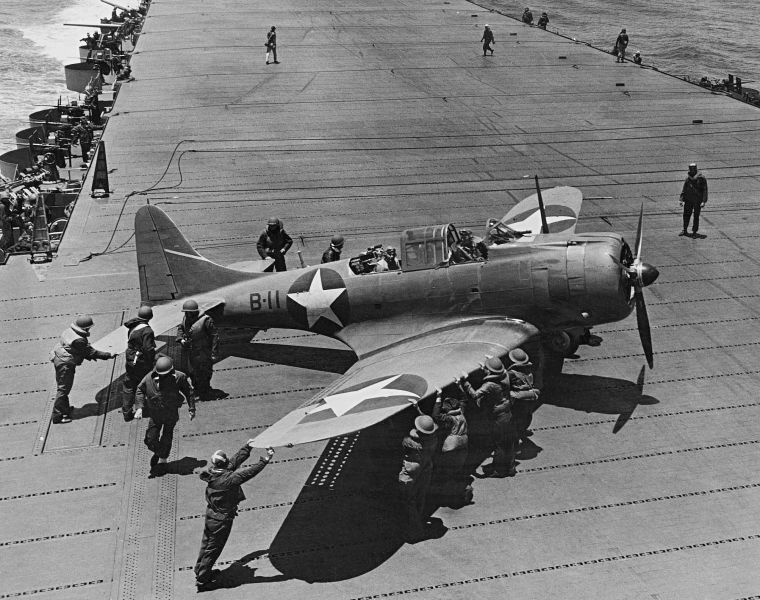
The US Navy had scored the biggest upset victory in the service's history, with an inferior force inflicting a staggering defeat on a superior one, sinking almost half of the IJN's carrier tonnage. The YORKTOWN was lost, but over the long run the Americans could make good their losses far more easily than the Japanese. The Japanese offensive across the Pacific had finally reached high tide, though the Americans had a year or more of hard fighting ahead of them before the tide would clearly shift back against the Japanese.
* The SBD played a crucial role at Midway, and would have paid for itself just with that battle alone. However, although the Dauntless was a somewhat antiquated design, in particular lacking in performance and with light machine-gun armament, it was rugged as well as effective, and Navy and Marine flight crews acquired an affinity for it. It was noisy and drafty to fly, but it handled well.
The virtues of the "Slow But Deadly" Dauntless seemed to more than make up for its defects, and though it was to be replaced by the Curtiss SB2C Helldiver, as discussed later the Helldiver proved a very troublesome aircraft, and the Dauntless would hang on in service much longer than anyone expected. It served with distinction in the fight for Guadalcanal, beginning in August 1942, and in the invasion of North Africa, Operation TORCH, in November 1942. The Dauntless would also fly in an operation against Nazi installations in Norway in October 1943, but otherwise its further operations against the Germans would be in the antisubmarine warfare role, carrying depth charges.
BACK_TO_TOP* Further variants of the Dauntless were produced. The SBD-4 was very similar to the SBD-3 but featured a 24-volt DC electrical system, replacing the older 12-volt DC system. The updated power system was intended to support improved avionics, including navigation gear and the ASB longwave radar, with a Yagi "fishbone"-style antenna under each wing. Production constraints on the ASB meant that early SBD-4s were not delivered with radar, being updated with it in the field. The SBD-4 also featured a new Hamilton Standard constant-speed variable propeller. The old spinner was no longer fitted, it having been often removed from Dauntlesses in the field anyway. The Navy and Marines received 780 SBD-4s, with deliveries beginning in October 1942.
* The SBD-5 was the definitive Dauntless model, featuring a further uprated Wright R-1820-60 Cyclone engine with 890 kW (1,200 HP), with a modified cowling that eliminated the carburetor intake scoop in the upper lip. A second, very noticeable change was the replacement of the old telescopic sight, which tended to fog up in rapid dives, with a modern reflector sight. Due to an increase in empty weight, the additional power didn't result in a significant increase in performance. The additional weight also meant less range, but the SBD-5 featured "wet" wing pylons to allow it to carry an external tank with a capacity of 220 liters (58 US gallons) on each wing, instead of a bomb or depth charge.
_______________________________________________________________
DOUGLAS SBD-5 DAUNTLESS:
_______________________________________________________________
wingspan:
12.66 meters (41 feet 6.5 inches)
wing area:
30.2 sq_meters (325 sq_feet)
length:
10.09 meters (33 feet 1.5 inches)
height:
4.14 meters (13 feet 7 inches)
empty weight:
2,963 kilograms (6,533 pounds)
max loaded weight:
4,854 kilograms (10,700 pounds)
maximum speed:
406 KPH (252 MPH / 220 KT)
service ceiling:
7,955 meters (26,100 feet)
range:
1,794 kilometers (1,115 MI / 970 NMI)
_______________________________________________________________
The Navy obtained 2,965 SBD-5s. Although the Dauntless was seen as clearly past its prime, with the lack of folding wings being a severe sore point for carrier operations, when the US Navy began to obtain new carriers in mid-1943 to conduct offensive operations against Japan's Pacific empire, the Dauntless was at the forefront. It would remain so into 1944, with its swan song in full carrier operations being the invasion of the Marianas in June 1944. The Dauntless would continue to fight from land bases in a secondary role to the end of the war.

By mid-1943, the general color pattern for a Dauntless was three-color, with light gray underneath, along with medium and light blue gray on top. National insignia featured a red outline for a time, but this scheme didn't work out and was quickly abandoned. Dauntlesses flying on Atlantic patrol were painted flat white with dark gull gray patterning topside. Some pictures survive of Dauntlesses in overall dark blue, a common US Navy color scheme late in the war.
* The SBD-6 was the last production variant of the Dauntless, and featured a further uprated R-1820-66 engine with 1,010 kW (1,350 HP) as well as improved fuel tanks. A total of 450 was produced, with the very last SBD delivered in 1944. The Dauntless was seen as so obsolescent by that time that the SBD-6 wasn't even sent to combat zones, being used for coastal patrol, training, and in the hack role. The Dauntless was quickly withdrawn from Navy and Marine service after the war.
Some sources indicate that small numbers of Dauntlesses were either converted or built as photo-reconnaissance machines, with the designations of "SBD-1P", "SBD-2P", "SBD-3P", and "SBD-4P". However, clear details of these machines are hard to find.
BACK_TO_TOP* The Dauntless was used by other air services, but somehow failed to achieve the distinctions made by Navy and Marine SBDs.
The US Army Air Forces (USAAF) took note of the success of the German Ju 87 Stuka dive bomber during the Nazi conquest of France in the spring of 1940, and decided to obtain dive bombers of their own. The Dauntless seemed like it could do the job in the short term, and so the USAAF ordered 78 SBD-3s with no arresting hook and a bigger, pneumatic rear tire. They were given the designation of "A-24 Banshee", and delivered in the last half of 1941. USAAF crews never developed good rapport with the aircraft, and it suffered badly in combat with Japanese fighters. It was withdrawn from operational service before the end of 1942, to be used for training.
The USAAF did obtain later versions of the Dauntless, however, including 170 modified SBD-4s under the designation of "A-24A" and 615 SBD-5s with the designation "A-24B". Although the A-24A and A-24B didn't see combat with the USAAF, 60 of the A-24Bs ended up being passed on to Marine service as "SBD-5As". Ironically, despite the Air Force's lack of enthusiasm for the type, it remained in service until 1950. Some sources claim a single A-24A was converted into a target drone, with a single A-24B converted into a drone controller, but once again details are unclear. Typical USAAF colors for the A-24 were light gray on the bottom and olive drab on top.
* The British were provided with nine SBD-5s for evaluation, which were designated "Dauntless Mark I". However, neither the British Royal Air Force nor the Royal Navy's Fleet Air Arm were very interested in dive bombers, and though the evaluation was extensive, nothing came of it, the conclusion being that the Dauntless was vulnerable and tiring to fly.
The Royal New Zealand Air Force received 18 SBD-3s and 23 SDB-4s, and did use them successfully in combat in the South Pacific. The Free French used about 80 SBD-5s and A-24Bs as trainers and close-support aircraft. The French Dauntlesses would be the last of the type to see combat, operating during the Indochina War off the carrier ARROMANCHES. The French Navy removed the Dauntless from combat status in 1949, but the SBD was still operated in the training role until 1953.
The Mexican Air Force operated a handful of Dauntlesses for patrol, and was the last military organization to fly the type, removing it from service in 1959. A few were flown in civilian hands for a time, with the excellent handling of the Dauntless appreciated by sport pilots. A number survive as static displays, and at least one was still flying on the airshow circuit at last notice.
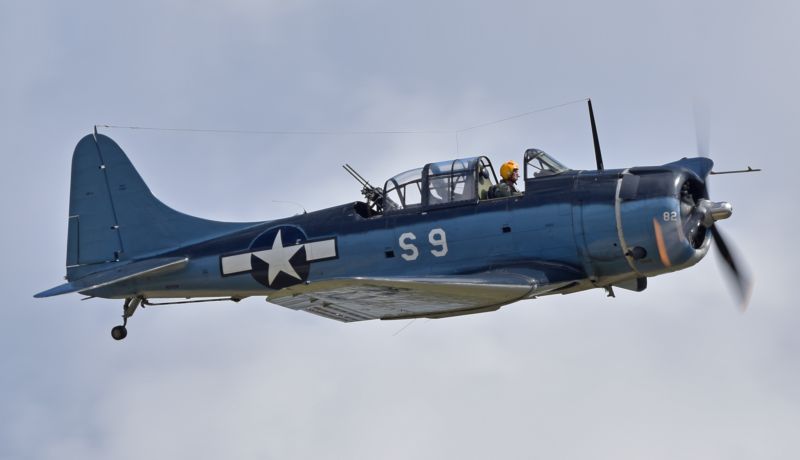
* The following list gives Dauntless variants and production:
That gave total production of 4,924 SBDs, 863 A-24s, and 5,787 Dauntlesses in all. While the Dauntless could not be described as one of the best aircraft of World War II in the technical sense, it definitely had its virtues, and its contributions to Allied victory were considerable. Its place in the history books is thoroughly deserved.
BACK_TO_TOP* The origins of the Dauntless's replacement, the Curtiss Helldiver, went back to 1933, when the Curtiss-Wright company flew a prototype of a two-seat carrier-based fighter, the "Model 73", with the original service designation of "XF12C-1". After some reconsideration, the Model 73 was redefined as a scouting aircraft, being redesignated "XS4C-1" -- and then, in early 1934, was redefined again as a scout / dive bomber, obtaining yet another designation as the "XSBC-1".
As it emerged through a series of changes, the XSBC-1 was a parasol-wing monoplane with retractable taildragger landing gear, the main gear tucking up into the fuselage; it was powered by a Wright R-1820-80 Cyclone 9-cylinder, air-cooled radial engine, providing 520 kW (700 HP), driving a two-bladed propeller. The XSBC-1 was badly damaged in September 1934 after a structural failure, and written off.
The parasol wing was clearly unsuited to the dive-bombing role, so the Navy ordered another prototype, the "Model 77" or "XSBC-2", with staggered biplane wings, being powered by a two-row 14-cylinder Wright R-1510-12 Whirlwind 14 air-cooled radial with 520 kW (700 HP). In 1936, the engine was changed to a two-row 14-cylinder Pratt & Whitney R-1535-82 Twin Wasp Junior engine, with the same power rating, being redesignated "XSBC-3".
That proving satisfactory, the Navy ordered 83 production "Model 77A" or "SBC-3" machines, with initial deliveries in 1937, the type being given the name of "Helldiver". A late production SBC-3 was refitted with a Wright R-1820-22 Cyclone, to be redesignated "XSBC-4". An order for 174 production "Model 77B" or "SBC-4" machines followed, with the first delivered to the US Navy in the spring of 1939. War in Europe broke out later in the year, with France ordering 90 with self-sealing tanks; in early 1940, as a stopgap until production machines arrived, the Navy provided the French with 50 in-service SBC-4s. By the time they arrived, France had fallen to Germany, with the British obtaining five of the lot. They didn't have much use for them, relegating them to ground-instruction duties. The British named them "Cleveland".
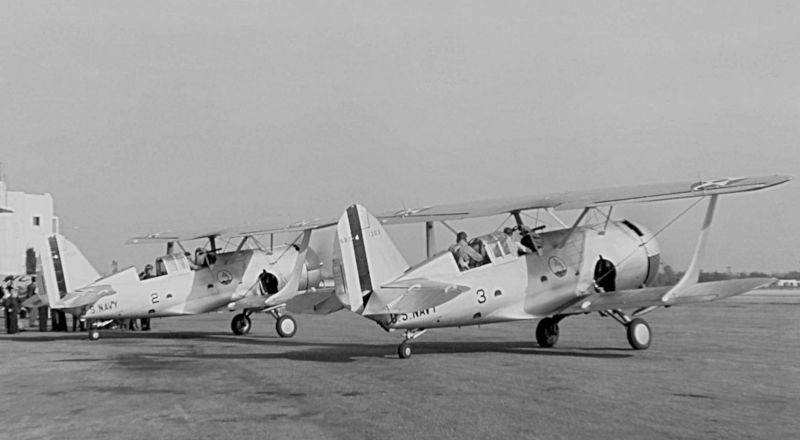
* When the USA entered the war in December 1941, SBC-4s equipped one Navy and one Marine squadron -- but the type was obsolete, being relegated to training and phased out. In 1938, the Navy had issued a requirement for a replacement, requesting designs for a new carrier-based monoplane scout bomber. The specification detailed an aircraft that would have two crew, carry a 450-kilogram (1,000-pound) bomb in an internal bay, and have long range. It was also to be rugged enough to handle the dive-bombing role.
A new design team at Curtiss under Raymond C. Blaylock came up with what looked like a monoplane follow-up to the SBC series, with the designation "XSB2C-1". The only competitor was the broadly similar Brewster XSB2A-1 Buccaneer, both machines having a radial engine, mid-mounted wings, and a long tandem canopy. By the time of the first flight of the XSB2C-1 on 18 December 1940, production orders had already been placed for both the Curtiss and Brewster aircraft. About 771 Buccaneers would be built in all, with the type proving so badly underpowered and clumsy in flight that nobody ever tried to put it into combat service -- making the surprisingly large quantity of aircraft produced an apparent testimonial to the power of bureaucratic inertia.
The XSB2C-1 seemed much more the way of the future, at least on paper, and Curtiss ramped up production tooling to turn out the "Helldiver", as it had been named in honor of the earlier SBC, in large numbers. Unfortunately, the development program did not go well. There were of course the usual problems of trying to get leading-edge technologies to work, but the design also seemed to have fundamental problems, the first being that its handling was very poor, the second being that it lacked structural strength -- a criminal weakness in a dive bomber. However, the US military was ramping up rapidly for the war that was clearly coming and had committed heavily to production without even a flight evaluation, on the basis that the bugs could be worked out. This policy would pay dividends in many cases, but it was inevitable that it would lead to troubles in others.
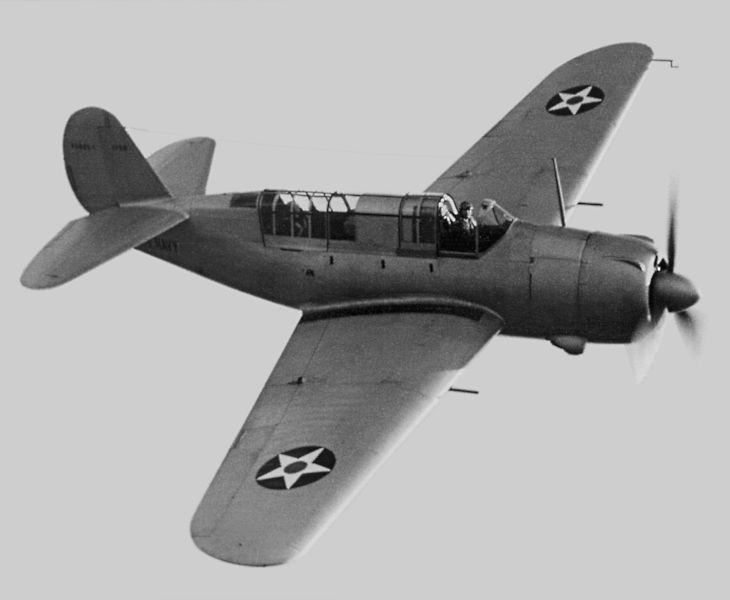
* On 8 February 1941, the Helldiver prototype slammed into the ground after its engine failed on approach and was badly damaged. The program was already behind schedule and Curtiss frantically rebuilt the machine. There were so many changes to clean up the obvious deficiencies of the type that when it finally returned to the air on 20 October 1941, it was almost a completely new aircraft design.
Curtiss was supposed to be delivering production aircraft to the Navy by December 1941, and the USAAF had also ordered 900 as the "A-25A Shrike", with carrier gear deleted and other tweaky changes. Unfortunately, the prototype was lost for good on 21 December 1941 when it broke up in the air, pilot B.T. Hulse bailing out safely -- the incident suggesting more troubles down the road. The first production machine was finally completed in June 1942, being rolled out from a plant in Columbus, Ohio, which would build all of the Curtiss Helldivers. Navy officials noted that the Grumman TBF Avenger torpedo bomber was already in combat, even though development had begun two years after the start of the Helldiver program.
Navy service acceptance trials of the first six production machines revealed that the Helldiver was badly overweight due to the changes implemented during its protracted development. The cleanup performed by Curtiss engineers had only limited effect in improving the type's handling, and the weight increase helped negate much of that. Some of the problems were unfixable: the requirement that the Helldiver fit on carrier elevators limited its length, making it stubby and unstable along the longitudinal axis -- leading to the fit of an absurdly oversized tailfin. In any case, squadron deliveries began in December 1942. Pilots converting from the SBD Dauntless quickly suspected they had been handed a bad deal, and some carrier captains suggested that the Helldiver program be canceled.
BACK_TO_TOP* The SB2C-1 was an all-metal mid-wing monoplane with a 14-cylinder air-cooled two-row Wright R-2600-8 Double Cyclone radial engine providing 1,270 kW (1,700 HP), driving a three-bladed propeller with a large spinner. The wings featured ailerons outboard and flaps inboard; they manually folded straight up for carrier deck storage. The ailerons oddly had aluminum skinning on top and fabric on the bottom. There was a slat on the leading edge of the wing in front of the ailerons that was deployed automatically when the landing gear was extended to improve low-speed handling. The flaps were split at the wingfold, and had top and bottom sections to permit them to be used as dive brakes. The top surfaces were normally locked in place, with the bottom surfaces used as conventional flaps; both the bottom and top surfaces deployed when making a diving attack.
The rudder and elevators had metal frames with fabric skinning. The tailfin folded to the side to allow the aircraft to fit into the hangar deck. The SB2C-1 had a tailwheel landing gear arrangement, with the main gear hinging in the wings toward the fuselage and a fixed tailwheel, and there was a stinger-type arresting hook under the tail. Self-sealing fuel tanks and selective armor were fitted. The Helldiver had fore-and-aft greenhouse-style canopies that slid toward the center to open.
The SB2C-1 could carry a 450-kilogram (1,000-pound) bomb in its bomb bay, with the bomb swinging out on a crutch for delivery in a dive-bombing attack. Wing racks were later added to allow it to carry a store under wing, such as a 150-kilogram (325-pound) depth charge or smaller munition. Gun armament included four Browning M2 machine guns in the wings, plus a flexible mount in the rear cockpit initially fitted with a single M2 Browning, but later changed to twin 7.62 millimeter Brownings on a hydraulically-boosted ring mount. The XSB2C-1, incidentally, had started out with two guns in the nose cowling and no guns in the wings.
Only 200 SB2C-1s were built, with all remaining stateside for training, and some sources suggest they were only accepted because the delays in the program had become so politically charged, being targeted by government review committees, that heads were in danger of rolling. The 900 A-25A Shrikes ordered by the USAAF, which were much like the SB2C-1 except for lack of carrier gear, were completed but never actually saw any combat with the Army Air Forces. Some were used as target tugs, but the rest were given away -- with 410 passed on to the US Marines, 270 to the US Navy, and 10 to the Royal Australian Air Force. The Marines designated the A-25A the "SB2C-1A".
* The first variant to see combat was the "SB2C-1C", introduced in 1943. It featured additional fuel storage and the four Brownings in the wings replaced by two 20-millimeter cannon, with 400 rounds per gun. Provision was made for torpedo carriage, but torpedoes were rarely if ever carried in practice. 778 SB2C-1Cs were built, with the type performing its first major combat action in a raid against the Japanese stronghold at Rabaul on New Britain on 11 November 1943. Helldivers were originally painted light blue topside and white underneath, but within a few months overall dark sea blue would become standard Navy colors.
The Helldiver was not generally loved by crews, who called it the "Beast" and said that "SB2C" stood for "Son of a Bitch Second Class". It was so badly underpowered that it tended to fly off the carrier deck and simply drop into the sea. Curtiss engineers struggled to fix the problems; Curtiss president Guy Vaughn said the Helldiver was "one of the biggest wartime crosses we had to bear."
Only a single "XSB2C-2" was flown, that being a floatplane conversion of an early production SB2C-1 -- but though there were plans to acquire 350 of this variant, priorities changed and it didn't happen. The "XSB2C-3" was a production Helldiver fitted with the more powerful R-2600-20 Double Cyclone engine, with 1,420 kW (1,900 HP) and a four-bladed Curtiss electric propeller, helping to compensate for the aircraft's excessive weight. It went into production in 1944 as the "SB2C-3", with 1,112 built.
Most SB2C-3s were fitted with the ASB longwave radar with a Yagi fishbone-style array antenna under each wing for attacks in foul weather, but some were built with the much better AN/APS-4 centimetric radar in a pod under the wing, to be designated "SB2C-3E". Some sources claim that a radar "bombsight", the "low altitude bombing system (LABS)", was also carried by the Helldiver -- but LABS seems to have been generally carried by large multi-engine patrol aircraft, and there's little evidence of its use with the SB2C.
_________________________________________________________________
CURTISS SB2C-3 HELLDIVER:
_________________________________________________________________
wingspan:
15.14 meters (49 feet 9 inches)
wing area:
39.2 sq_meters (422 sq_feet)
length:
11.18 meters (36 feet 8 inches)
height (tail down):
4.49 meters (14 feet 9 inches)
empty weight:
4,760 kilograms (10,495 pounds)
max loaded weight:
7,600 kilograms (16,750 pounds)
maximum speed:
475 KPH (295 MPH / 255 KT)
service ceiling:
8,140 meters (26,700 feet)
range:
1,930 kilometers (1,200 MI / 1,045 NMI)
_________________________________________________________________
The SB2C-3 was more satisfactory than the SB2C-1, and the next variant, the "SB2C-4", did much to fix some of the Helldiver's remaining defects. It was generally stronger and featured perforated dive flaps that produced less buffet in a dive. It could carry four 12.7-centimeter (5-inch) "High Velocity Air Rockets (HVARs)", a 450-kilogram (1,000-pound) bomb, or a drop tank under each wing, in addition to the bomb bay stores. 2,045 SB2C-4s were built, making it the most heavily produced variant. As with the SB2C-3, ASB was standard, but some were fitted with the AN/APS-4 centimetric radar and designated "SB2C-4E". Although the bad reputation acquired by the Helldiver would stick forever, some aircrews were impressed by the virtues of the SB2C-4 and felt the complaints were overblown.
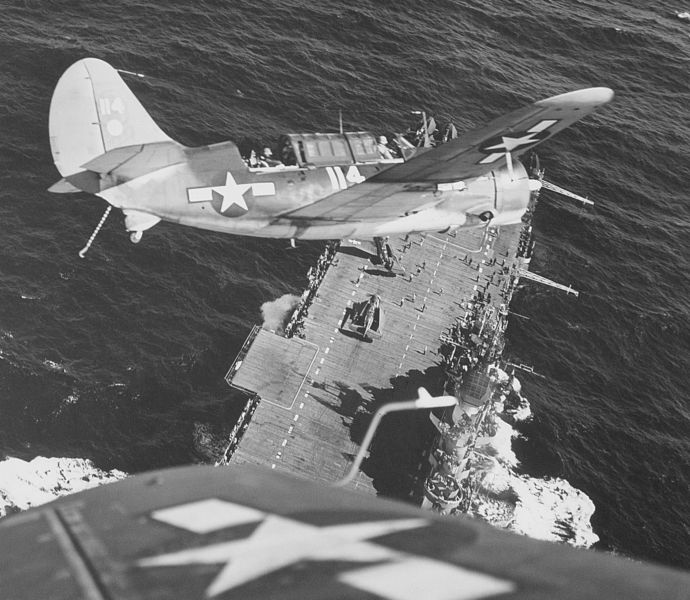
Two SB2C-4s were modified to provide still more internal fuel capacity, along with some other changes, and were given the designation of "XSB2C-5". This configuration went into production as the "SB2C-5", with 970 built. 2,500 more were on order when the war ended and Helldiver production ended. Two SB2C-3s were completely rebuilt with a Pratt & Whitney R-2800-28 Double Wasp engine, providing 1,565 kW (2,100 HP), and a longer fuselage, to be redesignated "XSB2C-6", but that variant never entered production.
In fact, even if the Helldiver met specification, it would have had no future anyway. The HVAR rocket turned out to be a perfectly adequate weapon for attacking ships, making the dive-bomber concept obsolete, and late-model fighters like the Grumman F6F Hellcat and Vought F4U Corsair could carry a comparable weapons load -- while being much better able to care for themselves once they had dropped their stores. By the end of the conflict, the detested Helldiver had been pushed to the margin. It was one of the nails in the coffin of Curtiss -- the company also having been afflicted by difficulties in getting the C-46 Commando cargolifter to fly right, and a bungling inability to design new fighters competitive with those of other US manufacturers.
In the prewar period, Curtiss aircraft had been highly regarded, but during World War II it became obvious that the company's engineering culture had all but fallen apart -- suggesting the rise of incompetent management that was despised by employees. In 1948, following the failure to sell any jet aircraft designs to the US military, Curtiss-Wright sold off its aircraft product line to North American Aviation, the remainder of the company staying in business as a components manufacturer.
Curtiss built 6,006 Helldivers in all, variants including:
Fairchild of Canada and the Canadian Car Foundry (CCF) company were also tapped early on to build the Helldiver, with the two companies producing a large quantity of machines. Fairchild Helldivers were given the "SBF" designation, while CCF machines were given the "SBW" designation. Production quantities were as follows, with the corresponding Curtiss-built variant in parenthesis:
Originally, Canadian production had been in part set up to provide aircraft for Lend-Lease deliveries to US allies. 26 of the 18 SBW-1Bs built by CCF were provided to the Royal Navy Fleet Air Arm for evaluation, with the final report completely rejecting the machine as unsuitable for combat operations. Well-known test pilot Eric Brown, who flew in the evaluation, described the Helldiver with British understatement as "this unpleasant aircraft". The rest of Canadian production ended up in US hands.
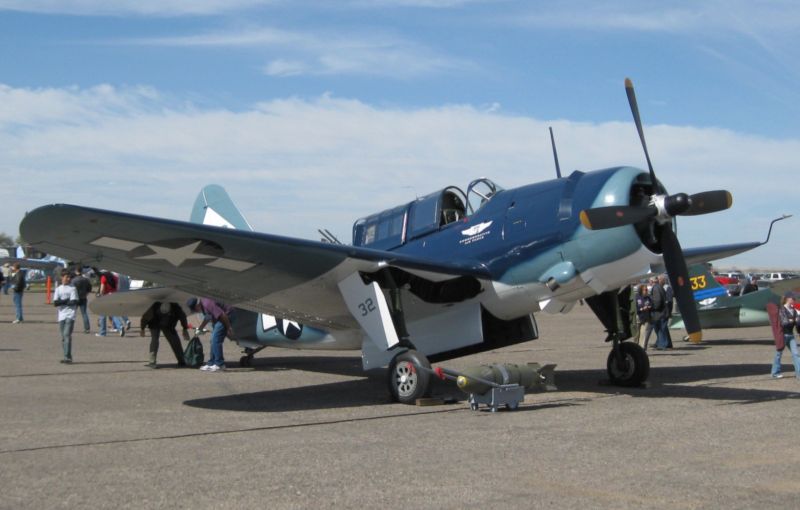
Helldivers stayed in service with the US Navy until at least 1947, being used as target tugs and in other second-line duties. In the postwar period, it was flown by the air forces of Greece and Thailand, and the naval air arms of Italy, Portugal, and France. Greek Helldivers saw action in the civil war and French Helldivers saw combat in the Indochina conflict. A number of Helldivers survive today, mostly as static exhibits, but one is airworthy and appears at airshows.
BACK_TO_TOP* The Dauntless and the Helldiver seem to provide their own lessons in technology. The Dauntless demonstrated that an obsolescent weapon with a mixed bag of virtues and flaws could be used to very good effect by aircrews who knew how to make use of the virtues and deal with the flaws.
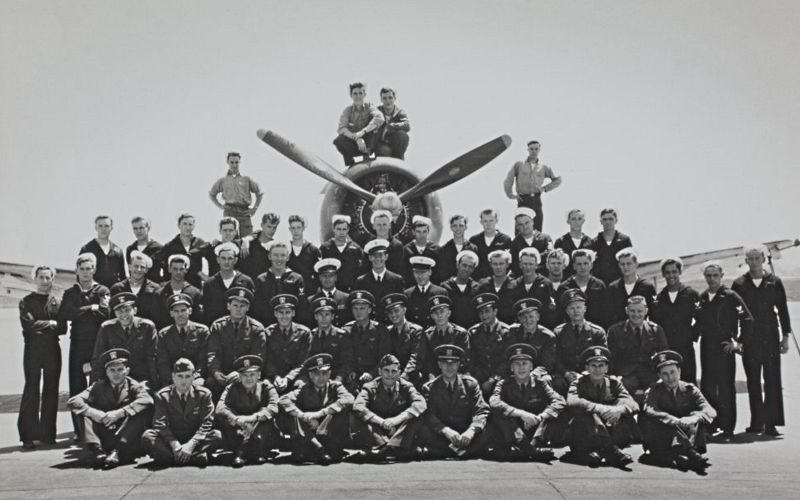
The Helldiver demonstrated how some products, having got off on the wrong foot, can have terrible problems getting back on the right one. It seems that in the end Curtiss was able to produce a satisfactory aircraft, but in the absence of any great praise for the type, it has never lived down its bad reputation. There is also the fact that few would find the Helldiver elegant and inspiring in appearance, ensuring that it would suffer from the old prejudice that "no aircraft that looks that bad that could possibly be any good."
* Sources include:
The SBD, despite its significance, is not all that well documented, and there are major discrepancies between sources on various details of armament and the like.
* Illustrations credits:
* Revision history:
v1.0.0 / 01 feb 07 v1.0.1 / 01 may 07 / Follow-up polishing release. v1.0.2 / 01 apr 09 / Review & polish. v1.0.3 / 01 nov 10 / Review & polish. v1.0.4 / 01 oct 12 / Review & polish. v1.0.5 / 01 sep 14 / Review & polish. v1.0.6 / 01 aug 16 / Review & polish. v1.0.7 / 01 jul 18 / Review & polish. v1.0.8 / 01 may 20 / Review & polish. v1.1.0 / 01 may 20 / Review & polish. v1.2.0 / 01 sep 22 / Illustrations update, SBC information. v1.2.1 / 01 jul 24 / Review & polish.BACK_TO_TOP
